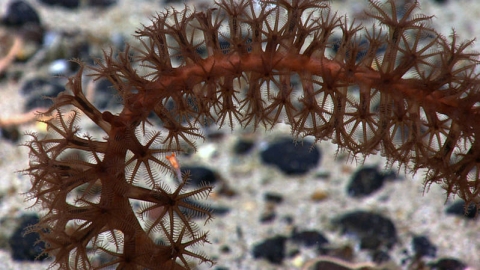About Us
On September 15, 2016, the Northeast Canyons and Seamounts Marine National Monument was established by Presidential Proclamation, making it the first and only marine national monument marine national monument
A marine national monument is an ocean area designated by a presidential proclamation under the Antiquities Act. The U.S. Fish and Wildlife Service partners with the National Oceanic and Atmospheric Administration (NOAA), state and territorial governments and others to manage marine national monuments that conserve the ocean and remote islands and atolls within the National Wildlife Refuge System.
Learn more about marine national monument in the Atlantic Ocean. The Monument is located 130 miles off Cape Cod, Massachusetts and is approximately the size of Connecticut (3.1 million acres). The Monument has 2 separate units: The Canyons unit, which has 3 undersea canyons; and the Seamounts unit, which has 4 undersea mountains. The U.S. Fish and Wildlife Service, in the Department of Interior, and the National Oceanic and Atmospheric Administration, in the Department of Commerce, jointly manage the monument.
The Northeast Canyons and Seamounts Marine National Monument was established to protect and conserve its unique and pristine ocean habitats, historic objects, and features of high scientific interests for current and future generations of Americans.
The monument is renowned for its rich and unique biodiversity, including deep-sea coral communities and concentrations of marine wildlife. Its unique features create conditions high concentrations of ocean-dwelling animals. Species that rely on the monument include whales, dolphins, and turtles, as well as fish that migrate long distances, such as tunas, billfish, swordfish, and sharks. Large numbers of seabirds also rely on this area for food, including Atlantic puffins.
Geographic Features
The Monument is comprised of two units: the Seamounts unit and the Canyons unit. The Seamounts Unit has four undersea mountains - Bear, Mytilus, Physalia, and Retriever seamounts. The Canyons Unit has three undersea canyons – the Oceanographer, Lydonia, and Gilbert canyons. Both units include the waters and submerged lands within their respective boundaries.
Canyons
There are three undersea canyons – Oceanographer, Gilbert, and Lydonia – within the monument. These canyons are the largest of about 35 major undersea canyons lining the U.S. continental shelf’s edge from Cape Hatteras north to the Canadian boundary. The canyons formed by erosion, cutting into the continental slope and lower continental shelf, which created their steep walls. From the lip of Oceanographer Canyon to its deepest location, the canyon is approximately 4,000 feet deep. This is the average depth of the Grand Canyon!
Upwellings of deep, cold water around the canyons bring nutrients that support large quantities of plankton, krill, forage fish, and schools of squid, which in turn, nurture high abundances of large marine animals such as, whales, dolphins, and large migratory fish.
Seamounts
There are four undersea mountains or seamounts – Bear, Physalia, Retriever, and Mytilus – within the monument. These seamounts are part of the New England seamount chain, which were created from a mantle-plume hotspot. This same process created New Hampshire’s White Mountains as the hotspot migrated eastward under the North American Tectonic Plate. The Monument’s seamounts rise thousands of feet above the ocean floor, comparable to the height of the Appalachian Mountains. They are largely funnel-shaped, although wave erosion over time has caused some, including Bear and Mytilus, peaks to flatten. Seamounts with a flattened top are referred to as guyots.
The seamounts are biological "islands" in the deep-sea. Their isolation, unique topography, and water current patterns create ideal conditions for marine life to prosper. As currents flow up and around the seamounts, eddies form, helping to keep larvae and other small organisms positioned over the seamount. These currents also bring food to the filter-feeding corals and sponges growing in abundance here. Like the canyons, the rock and minerals on these seamounts varies widely, resulting in a variety of species being found close together, leading scientists to refer to the seamounts as “ocean oases.”



